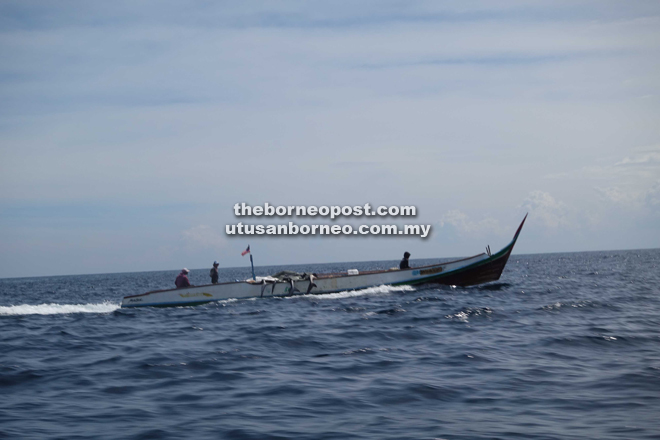
This photo of a boat ferrying dead sharks was taken by a tourist from Sweden in waters near Pulau Mabul in Semporna on July 22, and later shared with the Sabah Shark Protection Association.
SEMPORNA: Just days after photos of dead sharks emerged from Pulau Mabul off here, tourists caught on camera sharks slumped on a long boat, the tails of at least four hanging on the side.
Having just returned to their boat after a dive off the reef on Ribbon Valley on the south side of Mabul on July 22, tourists from Sweden said they were disappointed as this was not something they had expected to see on their vacation.
Jonas Neander who shared the photo with the Sabah Shark Protection Association (SSPA), said he was upset to witness the boat zooming by with sharks, so close to the dive haven of Sipadan.
“I couldn’t believe it when we came up after the dive and saw the boat with the shark tails clearly hanging over the edge – in the middle of the day!
“We had followed the online updates about the finning on Mabul – but to see it (dead sharks) with our own eyes was so disappointing, especially given the spectacular biodiversity of these waters, which bring us back year after year,” Neander said.
Fellow diver Ewa Hansen said it does not matter where the sharks are from and supports efforts to ensure protection of the species.
“We have heard about the plans to create safe havens for sharks in Sabah – we applaud this initiative, especially if it involves alternative livelihoods for those who currently catch the sharks.
“These plans show great leadership and forward thinking. It would be amazing to see such protection for this area, it would ensure people can keep coming and enjoying the diving and wildlife here for years to come,” Hansen said.
A scientific study of sharks in Sabah’s east coast, particularly the Semporna region by the Australian Institute of Marine Science (AIMS) in 2012 valued a single living shark in Sabah’s waters at USD 815,000 (about RM3.6 million) to Sabah in terms of tourism revenue, compared with USD 100 (about RM440) for its fins.
In a statement, SSPA said it was deplorable that divers who visit Sabah in particular the Semporna region, are witnessing the destruction of sharks before their very eyes.
“It is sad and unfortunate that tourists who are supporting the local economy by diving in Sabah are seeing dead sharks while on holiday.
“They are here to appreciate what Sabah has to offer in terms of his biodiversity and we have an obligation to ensure sharks remain in our waters, not just for the economic spin-off, but also to ensure the health of the marine ecosystem, in which sharks play a vital role as apex predators,” the grouping said, adding that it could not verify the species of sharks that were seen on the boat.
SSPA said conservation groups in Sabah are working hard to protect sharks and that State Tourism, Culture and Environment Minister Datuk Seri Masidi Manjun is vocal about the subject – yet unable to make much headway as the Federal Agriculture and Agro-Based Industry Ministry does not seem willing to amend the law to provide protection for more shark species or to include a ban on shark hunting.
“Protecting sharks will benefit fishermen and the local economy, while ensuring the future of Sabah’s diverse marine life. We must all work together to save Sabah sharks,” SSPA said.
Global shark tourism generates a revenue of around USD 314 million annually and is expected to keep growing to a potential USD 780 million annually over the next 20 years.
SSPA is comprised of the Malaysian Nature Society (Sabah branch), Marine Conservation Society (MCS), Shark, Education, Awareness and Survival (SEAS), Scubazoo, Tropical Research and Conservation Centre (TRACC), WWF-Malaysia, Shark Stewards and Land Empowerment Animals People (LEAP).
